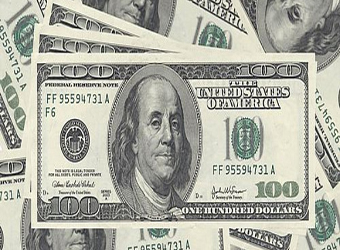The dollar stood tall on Tuesday as a rout in global equities prompted anxious investors to cut exposure to riskier assets and seek shelter in the relative safety of the greenback.
The U.S. currency held firm against most of its counterparts with the exception of the yen, which is the perennial safe-haven bet during times of risk aversion.
Against the yen, the greenback fell 0.3 percent to 108.73 yen, coming under pressure as the U.S. 10-year Treasury yield slid about 11 basis points to 2.685 percent in Asian trade.
Investor risk aversion triggered a drop in U.S. bond yields, leading to the fall in the dollar against the yen, said Sim Moh Siong, FX strategist for Bank of Singapore.
“I would see 107 to 108 as the next support for dollar/yen,” Sim said, adding that if the selloff picks up further steam the dollar could fall towards 104 yen.
The euro was steady at $1.2370 after shedding 0.7 percent overnight to pull further away from a three-year high of $1.2538 set late in January.
The dollar index against a basket of six major currencies stood at 89.610. Since Friday, when the selloff in equities began in earnest, the index has gained about 1.1 percent.
Emerging Asian currencies retreated, with the Malaysian ringgit and Indonesian rupiah both slipping around 0.4 percent against the dollar.
The U.S. currency was on the back foot as recently as late January, when the dollar index fell to a three-year trough of 88.438, hurt by a range of factors including concerns about U.S. trade protectionism and perceptions of narrowing yield advantage.
It caught a break, however, lifted by Friday’s robust U.S. employment report and the punishing sell-off in the recently bullish global equity markets.
“We are seeing a big rewinding of positions that had been built up since the start of the year, such as euro longs,” said Masafumi Yamamoto, chief forex strategist at Mizuho Securities in Tokyo.
“The stock market plunge caused by the jump in yields has been the trigger. Investors hurting from the drop in equities are seen trying to limit their losses by selling recently bullish currencies like the euro, which in turn supports the dollar.”
The dollar also tends to benefit from its perceived safe-haven status at times of market ructions.
The shakeout persisted in Tuesday’s Asian trade, with U.S. S&P futures tumbling 2.5 percent to 4-month lows at one point, while markets in Asia took another battering.
That came after the Dow, which rose to a record high late in January, fell 2.5 percent on Friday and plunged 4.6 percent on Monday.
The sharp pullback comes amid concerns about higher inflation, sending U.S. 10-year bond yields surging to a four-year top on Monday. Friday’s U.S. jobs report was the latest jolt to financial markets, as strong wages growth reinforced the inflation and monetary tightening
speculation, with traders betting the Federal Reserve might raise rates at a faster pace than expected this year.
The pound touched a two-week low of $1.3937 on Tuesday after dropping more than 1 percent overnight. Sterling, which hit a 1-1/2-year high of $1.4346 late last month, was fetching $1.3957.
The Australian dollar touched a three-week low of $0.7855 and was last down 0.1 percent at $0.7870. The Aussie had advanced to over a 2-1/2-year top at $0.8136 on January 26.


